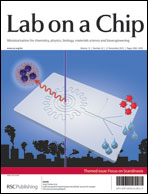Silicon-on-glass pore network micromodels with oxygen-sensing fluorophore films for chemical imaging and defined spatial structure†
Abstract
Pore network microfluidic models were fabricated by a silicon-on-glass technique that provides the precision advantage of dry etched silicon while creating a structure that is transparent across all microfluidic channels and pores, and can be imaged from either side. A silicon layer is bonded to an underlying borosilicate glass substrate and thinned to the desired height of the microfluidic channels and pores. The silicon is then patterned and through-etched by deep


 Please wait while we load your content...
Please wait while we load your content...